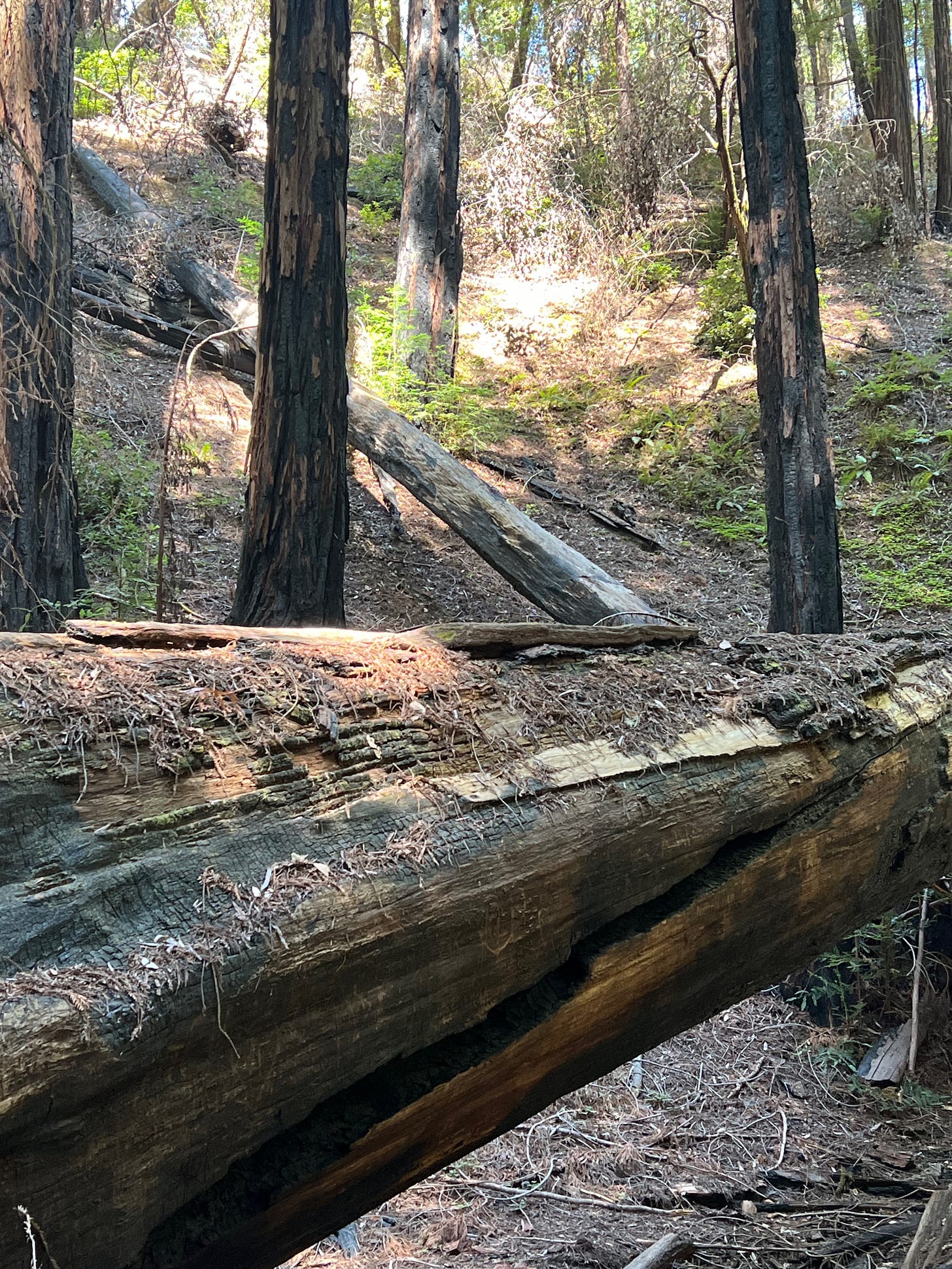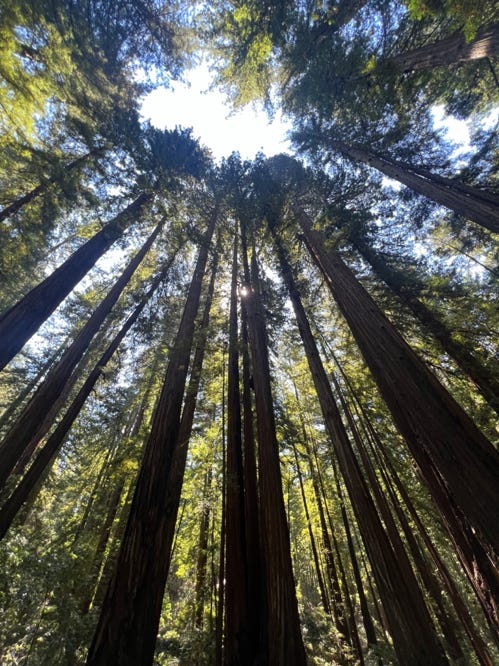The Armstrong Redwoods Natural Reserve in Sonoma County preserves some of the world’s oldest and tallest Coast Redwoods. A few minutes into the park’s roads or pathways and you are surrounded by redwoods hundreds of feet high, soothed by soft green light filtering through feathered branches, quieted by soft duff on the forest floor, taken in by the giant living forest.
Look again, though, and you will see destruction everywhere. Downed trees, roots tilting from the ground a dozen feet in the air, fallen trunks angling off helter-skelter into the undergrowth, perhaps blackened and crumbling, dry limbs with brown needles gawking away from the trunks. Or, still standing, a trunk hollowed out and charred by wildfires past.
The forest is not only living, it is dying. Has died. Continues to die.
But the first impression is the right one. There is death and destruction, but there is resilience, and life is winning. The fallen giants leave no gaping hole in the forest, no desert on the forest floor. They lie instead among dozens of growing trees, some of them survivors that escaped destruction when the giants fell, others saplings that grew up later, drinking in sunlight that had been blocked by the fallen trees, feasting on nutrients released by the decay of their forebears. Trees die, the forest flourishes.
Our own lives are full of endings, even failure. Each day, acquaintances drift apart, tasks are completed or thwarted or sometimes simply abandoned, treasured items wear out or fall away lost or ignored. Other disruptions strike deeper: jobs are lost, homes are left behind, friends separate, marriages end, loved ones die—fallen giants in the forest of life.
The forest shows us what resilience looks like. The destruction of fallen trees leaves its mark, but the forest thrives. New beginnings are everywhere in the forest; they are everywhere in our lives. Vitality springs up not just in spite of destruction but often because of it.
And then there are fairy rings.
Here and there in the Armstrong Reserve and other old forests stand circles of redwoods, each tree the same age as the others in the ring. The circle of trees may be as small as a few feet across, but one in Armstrong Forest is dozens of feet across and supports over twenty trees. The redwoods in these circles grow from the roots of an origin tree, stimulated to spring upward when that tree falls. The fairy rings, holding the same genetic material as the origin tree, keep the fallen tree alive.
Now that I am approaching the age of 70, the fairy rings inspire me in a new way. I have good genes, and with a healthy dose of luck I may have as much as a third of my life ahead of me. But the uncertainty of life yields daily to the eventual certainty of the end of life. So, as much as I continue to plan for the future, thoughts about what I have done, what I will leave behind, start to creep in.
The fairy rings show me not so much the power of offspring (though they do that, too) as the power of roots. The origin tree of a fairy ring sends out its roots when it is alive. Those roots grow underground and invisible, but they nourish and hold up the vast bulk of the coastal redwood they grow from, a tree that could rise over 300 feet high. When the origin tree falls, though, the work of the roots is not done; now they nourish and support each of the trees in a fairy ring.
I think of the roots I have laid down—yes in my children, but also in the work I have done, the way I have done it, the relationships I have formed, the things I have said, the words I have written. They too may go underground, their influence invisible except as they support me. But fairy rings tell me my roots can also surface, take on new forms, and sustain the community I have inhabited just as the fairy rings sustain their forest.
This is not an idle hope. I have seen the roots of my ancestors—the fallen trees in the forest of my life—spring up in myself and my family. A passion for learning and a devotion to community that defined one ancestor now flourish across my family; a fortitude in the face of pioneer hardships seen in another now helps us cope with the disruptions of modern life. These roots spread silently, below ground, but their presence in the character of the living is undeniable. Some roots can be traced to particular ancestors; the origins of others are harder to trace, as invisible as the origin tree of a fairy ring, but the influence is no less real merely because the source is invisible.
And I can even see my own roots pop up now and then, particularly in the way my children are shaping their lives. In their thirties now, they often surprise me, recalling events of our shared past, forgotten by me but still influencing them. Sometimes they are lessons I meant to teach, lessons my children seemed to shrug off at the time but that somehow managed to take hold. But often the events my children remember were not lessons, simply the occurrences of everyday life, occurrences that defined our lives and how we live them, and that nourish and support my children still today.
Take a walk in the woods. Savor the living forest but look for the signs of destruction; they will not be hard to find. And then look at how that destruction supports the life of the forest, and take hope in every little seed you sow today, every root you stretch out into the nourishing world. Someday one of those roots may rise as tall as redwoods.






